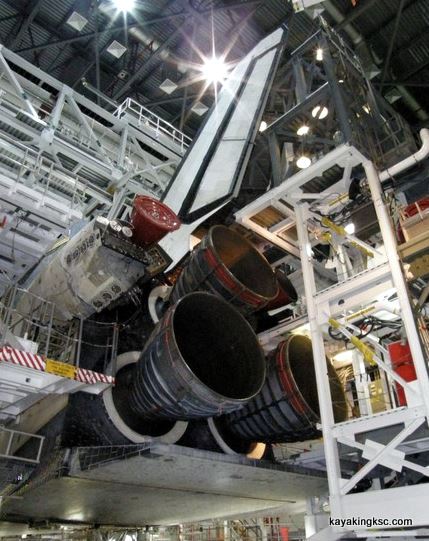
The forward rockets of the Reaction Control System, located near the nose of the Space Shuttle orbiter, included 14 primary and two vernier RCS rockets. These were all operations that required more thrust and impulse than mere attitude control. This system also executed any needed orbital maneuvers, including all changes in the orbit's altitude, orbital plane, and eccentricity.

This control system carried out the usual attitude control along the pitch, roll, and yaw axes during all of the flight phases of launching, orbiting, and re-entry. The Reaction Control System (RCS) was composed of 44 small liquid-fueled rocket thrusters and their very sophisticated fly-by-wire flight control system, which utilized computationally intensive digital Kalman filtering. Space Shuttle forward reaction control thrusters These, along with a movable body flap located underneath the main engines, controlled the orbiter during later stages of reentry. There were four elevons mounted at the trailing edges of the delta wings, and the combination rudder and speed brake was attached at the trailing edge of the vertical stabilizer.

The vertical stabilizer of the orbiter had a leading edge that was swept back at a 45-degree angle. The orbiters themselves did carry hypergolic propellants for their Reaction Control System (RCS) thrusters and Orbital Maneuvering System (OMS) engines.Ībout the size of a McDonnell Douglas DC-9, the Space Shuttle orbiter resembled an airplane in its design, with a standard-looking fuselage and two double delta wings, both swept wings at an angle of 81 degrees at their inner leading edges and 45 degrees at their outer leading edges. Additionally, two reusable solid rocket boosters (SRBs) provided additional thrust for approximately the first two minutes of launch.

In addition to their crews and payloads, the reusable orbiter carried most of the Space Shuttle System's liquid-propellant rocket system, but both the liquid hydrogen fuel and the liquid oxygen oxidizer for its three main rocket engines were fed from an external cryogenic propellant tank. Atlantis completed the final Shuttle flight, STS-135, on July 21, 2011. Discovery completed its final flight on March 9, 2011, and Endeavour completed its final flight on June 1, 2011. In 2003, Columbia was destroyed during re-entry, leaving just three remaining orbiters. Endeavour was built as Challenger 's successor, and was first launched in 1992. In 1986, Challenger was destroyed in an accident shortly after its 10th launch. Challenger, Discovery, and Atlantis followed in 1983, 1984, and 1985 respectively. The remaining orbiters were fully operational spacecraft, and were launched vertically as part of the Space Shuttle stack.Ĭolumbia was the first space-worthy orbiter it made its inaugural flight in 1981. Enterprise was partially disassembled and retired after completion of critical testing.
#NASA ORBITER PROCESSING FACILITY SHUTTLE FLO SERIES#
An unpowered glider, it was carried by a modified Boeing 747 airliner called the Shuttle Carrier Aircraft and released for a series of atmospheric test flights and landings. The first orbiter, Enterprise, made its maiden flight in 1977.

All were built in Palmdale, California, by the Pittsburgh, Pennsylvania-based Rockwell International company. Six orbiters were built for flight: Enterprise, Columbia, Challenger, Discovery, Atlantis, and Endeavour. space agency, this vehicle could carry astronauts and payloads into low Earth orbit, perform in-space operations, then re-enter the atmosphere and land as a glider, returning its crew and any on-board payload to the Earth. Operated from 1977 to 2011 by NASA, the U.S. The Space Shuttle orbiter is the spaceplane component of the Space Shuttle, a partially reusable orbital spacecraft system that was part of the discontinued Space Shuttle program. Discovery approaches the International Space Station (ISS) on STS-121


 0 kommentar(er)
0 kommentar(er)
